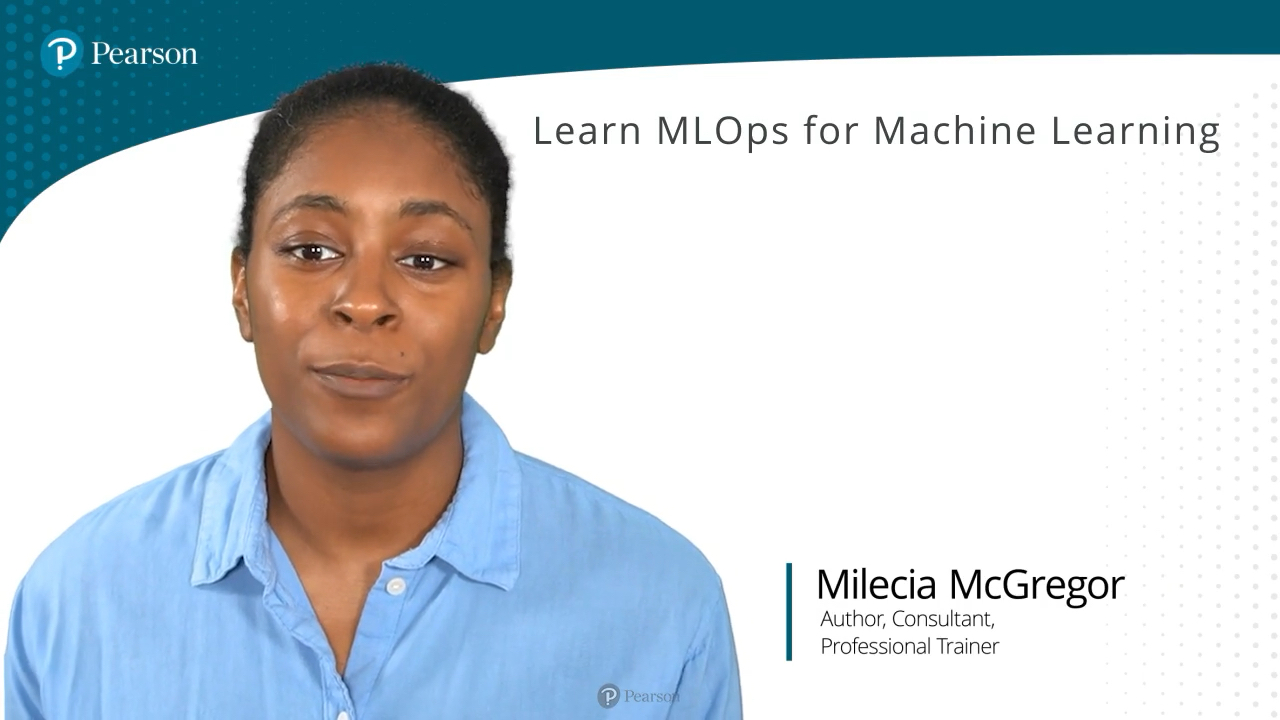Learn MLOps for Machine Learning (Video Training)
- By Milecia McGregor
- Published Sep 12, 2023 by Pearson IT Certification.
Online Video
- Your Price: $239.99
- List Price: $299.99
- About this video
Video accessible from your Account page after purchase.
Register your product to gain access to bonus material or receive a coupon.
Description
- Copyright 2024
- Edition: 1st
- Online Video
- ISBN-10: 0-13-820484-5
- ISBN-13: 978-0-13-820484-6
4+ Hours of Video Instruction
With both machine learning and DevOps at the forefront these days, Milecia McGregor helps engineers understand how to apply key DevOps principles to their machine learning projects.
When teams are working with machine learning models, changing features, different data sets, new algorithms, and unique computing resources all influence a machine learning model's performance. Tracking all of these items can be complicated. With tools such as DVC, MLFlow, AWS, you can meet the challenge. Milecia McGregor demonstrates how to use MLOps tools to improve machine learning and automate some of the steps in the process.
Skill Level:
- Beginner to Intermediate
What You Will Learn:
Developers and Engineers will learn how to:
- Capitalize on MLOps as an emerging field. Data-focused companies are looking for engineers with these skill sets.
- Build a basic MLOps pipeline from scratch with open-source tools - take a working template with you for your own projects
- Take ChatGPT into account to provide a practical bridge for engineers and DevOps teams.
Who Should Take This Course:
Job titles: Machine learning engineer, Data Engineer, DevOps teams
Course Requirements:
Pre-requisites: Familiarity with building ML models in Python, and managing data in AWS S3 buckets. Also, familiarity with Git and GitHub.
About Pearson Video Training
Pearson publishes expert-led video tutorials covering a wide selection of technology topics designed to teach you the skills you need to succeed. These professional and personal technology videos feature world-leading author instructors published by your trusted technology brands: Addison-Wesley, Cisco Press, Pearson IT Certification, Prentice Hall, Sams, and Que. Topics include IT Certification, Network Security, Cisco Technology, Programming, Web Development, Mobile Development, and more. Learn more about Pearson Video training athttp://www.informit.com/video.
Video Lessons are available for download for offline viewing within the streaming format. Look for the green arrow in each lesson.
Sample Content
Table of Contents
Introduction
Lesson 1: Learning the MLOps Pipeline
1.1 Gather the data
1.2 Analyze the data
1.3 Prepare the data
1.4 Train a model
1.5 Evaluate the model
1.6 Validate the model
1.7 Deploy the model
1.8 Monitor the model
Lesson 2: Handling the Data
2.1 Determine what the data sources are
2.2 Create ETL pipelines to compile the data
2.3 Understand the data schema with respect to the model
2.4 Identify data that can be used for the model
2.5 Perform feature engineering
2.6 Version the data with DVC
2.7 Make multiple data sets
2.8 MLOps best practices for data
Lesson 3: Creating a Model
3.1 Use common Python libraries
3.2 Code versioning with Git
3.3 Perform hyperparameter tuning
3.4 Track experiments with MLFlow
3.5 Track experiments with DVC
3.6 Evaluate the models
Lesson 4: Working with Production Models
4.1 Decide the best deployment method
4.2 Test on pre-production environments
4.3 Deploy to production
4.4 Monitor the model for drift
4.5 Validate the pipeline flow
4.6 Automation points in MLOps
4.7 Set up redeploy pipeline
Summary
More Information

